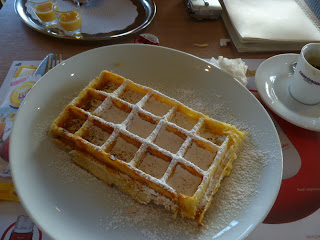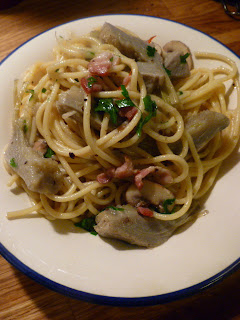Although no other meal on our trip across Belgium and the Southern Netherlands would match the terrific lunch we enjoyed at Kamu in Antwerp, that’s not to say we didn’t eat well elsewhere. In Belgium in particular there is no shortage of excellent places to eat. With the current strength of the Euro against the pound, the prices are consistently high, but so is the quality – and that’s got nothing to do with exchange rates.
Apart from mussels and other seafood, the main local speciality, a staple of almost every menu, was stoofpotje, or stew, available in a number of variants, but most commonly beef, slow cooked in the reliably fantastic local beer. Not exactly, necessarily, the ideal summer dish, but it was normally the cheapest option on the main course list, so perhaps it was as well that this June in Belgium was scarcely blazing.
The best example of stoofpotje we came across was at Bistro den Huzaar in Bruges. I had assumed, from the name, that the cooking there would be a Hungarian influenced take on Flemish cuisine, and their pig cheeks braised in kriek, with cherries could easily have been Eastern European in origin. Then again, as I’d already observed, the Belgians themselves are big into their cherries – as the very existence of kriek to braise your pig cheeks in would testify – so I couldn’t say for sure whether there is any substance to that assumption or not. Either way, the stew, which arrived in an earthenware casserole with it’s lid sealed with puff pastry, was rich and deeply flavoured, with just the right balance of savoury and sweetness, and the meat sumptuously tender. Definitely something I’ll be looking to recreate at home some day soon. The casserole, incidentally, contained plenty enough stew for two. This was not untypical of Belgian restaurants, which are generally as unstinting in their portions as their quality, to the point that although their prices are high, I wouldn’t say they were expensive for what you get on the plate. Perhaps the solution is to just order one starter and one main between two, but I don’t suppose that would endear you to your hosts…
Den Huzaar also supplied a couple of the other highlights of the week’s eating, in my starter of goose liver parfait, which was served with fruit bread and a sour apple compote, and Becca’s mango sorbet dessert.
It was also the place I was first inspired to take a photo of the after dinner coffee. It wasn’t the last:
 |
| Bistro den Huzaar, Bruges, Belgium |
 |
| Brasserie van Loock, Antwerp, Belgium |
 |
| Zoete-Genot, Arcen, Netherlands |
 |
| En Passant, Hulst, Netherlands |
By a number of accounts, Belgian restaurants have a pretty poor reputation for service. But I have to say, that wasn’t our experience at all, and, come on, if someone goes to that much trouble with the presentation of your coffee, then surely you can cut them a bit of slack elsewhere? The service we received, with a couple of individual exceptions, was generally charming, friendly and accommodating. It tended towards the informal, which I like, but I could see it running the risk of erring on the side of casual to some tastes.
Thinking about informality of service reminds me of one more meal that merits a mention. Perhaps perversely it was at an Italian deli and trattoria in Bruges called Trium, into which we’d stopped in search of a prosciutto panino or something similar to take away by way of a budget lunch, but were then tempted to take a table by the delicious smell and, for me at least, the promise of pasta alle vongole on the ‘suggesties’ board. Also, being Italian, staffed, it seemed, entirely by Italians, it provided something of a break from the minor but persistent shame of our complete lack of Flemish in the face of the near universally impeccable English of the waiting staff we encountered. However, when I asked, in Italian, for the pasta alle vongole, out Italian waiter appeared caught out, said he wasn’t sure if the vongole were available today, and that he’d have to talk to the chef. The chef, in the true sense of clearly being the man in charge, rather than the man doing most of the actual cooking, emerged from the open kitchen and came to our table. “You want the clams?” he asked, in English, jovially but with, perhaps, just a hint of underlying threat. I nodded, having mentally prepared myself for speaking Italian and finding myself speechless in English. “I do you clams, with potato, some beans,” he said. I looked at him, unsure whether we were misunderstanding each other, or if he was pulling my leg. I opened my mouth to say, no, I don’t need potatoes or beans, just clams and pasta, but he held up his hand to shut me up. “You want clams,” he said. “Trust me.” And he walked away.
When he returned, some ten minutes later it was with a huge bowl of linguine, with, as promised, not only clams, but potatoes and green beans stirred through it. Plus a vast platter of mixed cured meats that made up the antipasto di carne that Becca had ordered. I only realise in writing this that at Trium we had indeed followed the ordering policy I proposed above, but we did, and in fairness, it didn’t seem to make us unpopular. When we suggested that we would probably be sharing, far from being put out, he just brought an extra bowl for Becca, and then took the plate of meats away, insisting pasta first, then meat, was the proper order.
Linguine alle vongole, with potatoes and green beans is, clearly, an authenticist’s nightmare. It’s just plain wrong. Regular readers, though, will know that I am far from an authenticist, so it is with a deal of pleasure that I can report that, contrary to all known rules, it was actually really very good. Clear proof that the rules of authenticity are there to be broken. When we were done with the pasta, and the chef returned with Becca’s plate of cured meat, he asked how we found his version of linguine alle vongole. He seemed particularly delighted when not only did I say I enjoyed it, but pointed out that if he tried serving it up in Italy, everyone would think he was crazy. “It’s La cucina Italiana,” he said, “but done my way.” Good for him.
And just to round things off, and only because I think the picture’s pretty, here’s my steak tartare from Brasserie van Loock in Antwerp.













































